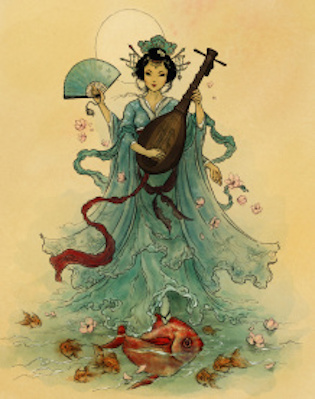 Benten, also known as Benzaiten, is one of the ‘Shici-fuku-jin’, or ‘Seven Gods of Luck’, in Japanese mythology. She is the patron goddess of literature, music, and wealth and like many other Japanese deities, had a dual purpose in both Buddhism and Shinto religion. Being the only female figure in the Shici-fuku-jin, she is also often considered a deity of femininity and is believed to be the deity of everything that flows: speech, knowledge, music, and water. Her role as the patron goddess of music has caused her to be seen as the protector of geishas, dancers and musicians.
Benten, also known as Benzaiten, is one of the ‘Shici-fuku-jin’, or ‘Seven Gods of Luck’, in Japanese mythology. She is the patron goddess of literature, music, and wealth and like many other Japanese deities, had a dual purpose in both Buddhism and Shinto religion. Being the only female figure in the Shici-fuku-jin, she is also often considered a deity of femininity and is believed to be the deity of everything that flows: speech, knowledge, music, and water. Her role as the patron goddess of music has caused her to be seen as the protector of geishas, dancers and musicians.
Benten is shown as a beautiful young woman playing a Biwa lute as mentioned in the Lotus Sutra, and is often shown with a serpent as her messenger. She is frequently depicted riding on, or being accompanied by, a sea dragon as a result of her marriage. Japanese mythology shows her marrying the violent sea dragon of Enoshima Island to prevent his ravages of its people.
Her existence is believed to have originated in Indian Hinduism with the goddess Sarasvatƒ´. During the introduction of Buddhism to Japan in the 6th century CE, the female deity became adopted into Japanese religion. Like Benten, Sarasvatƒ´ is shown holding a Veena flute. She is shown in the Rig Veda as killing a three-headed snake named Ahi, which accentuates her associations to the Japanese snake and dragon figures in the Japanese lore.
Before her adoption into the Japanese Pantheon as a prominent deity, Benten was believed to be a water deity. This can still be seen, as her temples are still more commonly found on islands and the coastal regions of the country. The Enoshima, Chikubu, and Itsukushima Islands are the locations of the three greatest shines to the deity in Japan. The Enoshima Engi, written by the Buddhist monk Kōkei in 1047 CE, tells of Benten as the third daughter of a dragon king called ‘Munetsuchi’. They were both believed to originate from the lake at the centre of the world that is found in ancient Buddhist tradition. Earlier Buddhist texts link the periodic appearance of comets in the sky with Benten. Those in 552 and 593 CE therefore showing that her worship was firmly established by this point.
In traditional Japanese Shinto religion, Benten is known as a female ‘Kami’. She is of such importance that she often has entire shrines dedicated to her such as the Zeniarai Benzaiten Ugafuku shrine in Kamakura and the Kawahara shrine in Nagoya. The Shinto Kami are the essence of the religion, with the best translation being the word ‘spirit’. However, they may be as important as elements of landscape or forces of nature. Kami are close to human beings and are believed to respond to human prayers. As a result, they are able to influence the course of natural and human events. It is in this form that Benten is the protector of those associated with femininity and music.
-Devon Allen
Junior Girl
Girl Museum Inc.
